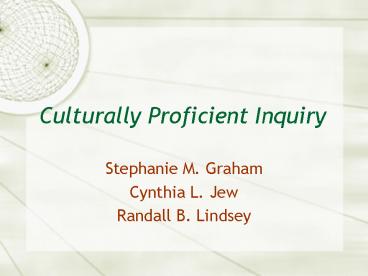Culturally Proficient Inquiry PowerPoint PPT Presentation
1 / 21
Title: Culturally Proficient Inquiry
1
Culturally Proficient Inquiry
- Stephanie M. Graham
- Cynthia L. Jew
- Randall B. Lindsey
2
. . . a high-quality public school system is
essential, not only for parents and guardians who
send their children to these schools but also for
the public good as a whole.
- Fullan, 2003
3
Purpose
- To focus our attention on education gaps that
persist in our schools - To illustrate applied use of the tools of
Cultural Proficiency - To discuss our responsibilities in narrowing
educational gaps
4
What We Know
- The achievement gap is historical
- The achievement gap is quantifiable
- The disparity between student demographic groups
is also available from qualitative data - The achievement gap persists in urban, suburban
and rural schools - The achievement gap is not just about test scores
5
Cultural Proficiency Tools
- Moral framework
- Barriers to Cultural Proficiency are historical
and current - Guiding Principles serve as core values to
overcome barriers - Ethical practices
- Continuum provides healthy language
- Essential Elements serve as standards
6
Barriers to Confronting Gaps
- Unwillingness or failure to acknowledge systemic
oppression as limitation for current practices - Unwillingness or failure to recognize role of
privilege in maintaining current practices - Unaware that it is we that make change
7
Guiding Principles as Core Values
- Culture is a predominant force in peoples and
schools lives - People are served in varying degrees by the
dominant culture - People have group identities and individual
identities - Diversity within cultures is vast and significant
- Each cultural group has unique cultural needs
- The best of both worlds enhances the capacity of
all
8
The Inquiry Approach
- Please refer to Figure 1.1, page 2 of Culturally
Proficient Inquiry - In what ways does this graphic represent current
practice in your school or district? - In what ways is this graphic different from
current practice in your school or district? - What questions does this graphic raise about
current practice in your school or district?
9
Peer Group Model
- Compare one demographic group to all other
students - e.g., white to non-white students
African-American to non-African-American
students or, male to female students - Use appropriate language development assessment
for English learners
10
Above Below the line Indicators
- Achievement Data are highly visible and
attainable above the line indicators of student
success - Access Data are less visible and attainable
below the line indicators of barriers to
student success
11
Achievement Data Examples
- Standards-based assessments
- Norm-referenced tests
12
Access Data Examples
- Student attendance
- Student suspensions
- Student dropout and expulsion rates
- Student enrollment in special programs - e.g.,
remedial, special education, honors, gifted and
talented, AVID - High school indicators - e.g., completion of
algebra graduation rates
13
Table Talk
- Read pages 57 to 59
- Take notes on your responses to Reflections
- Discuss with colleagues at your table your
responses, including insights and questions that
arise for you
14
The Continuum - Changing the Conversation
- Unhealthy Language
- Cultural Destructiveness
- Cultural Incapacity
- Cultural Blindness
- Healthy Language
- Cultural Precompetence
- Cultural Competence
- Cultural Proficiency
15
Standards for our Practice
- Assessing our knowledge of the cultures in our
community within our school - Valuing diversity is reflected in what we say, do
and develop as policy - Managing the dynamics of difference to insure
multiple perspectives - Adapting our practices to meet the diversity
within our school and community - Institutionalizing learning about the culture of
our school and the community we serve
16
Leverage Points for Change
- Curriculum Instruction
- Assessment and Accountability
- Parent and Community Communication and Outreach
- Professional Development
- See page 63
17
Rubrics Guide Below the Line Work
- The Essence (or, operational definition) of
each leverage point applied to the Continuum and
Essential Elements - Read and discuss with table partners your
observations, comments and questions
18
Rubrics as Illustrations
- Standards are met at Cultural Competence
- Rubrics guide professional values and behaviors
as well as institutional policy and practice
19
The CI Rubric
- Take a few minutes and scan the Curriculum and
Instruction rubric - Respond to the Reflection, page 88
- Engage your table partners in discussion of the
observations, comments and questions surfacing
for you
20
2 Important Processes
- Initial Steps in the Data Collection Process -
pages 57 58 - Steps for Conducting the Cultural Proficiency
Inquiry
21
Cultural Proficiency as Advocacy
- Do we have the will
- to educate all children?
- -
Hilliard, 1991

